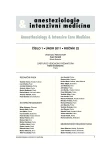Evolution of Anaesthesiology and Resuscitation at Prague’s Medical Faculties
Authors:
Pokorný Jiří, sen.
Authors‘ workplace:
Komise pro historii oboru České společnosti anesteziologie, resuscitace a intenzivní medicíny
Published in:
Anest. intenziv. Med., 22, 2011, č. 1, s. 33-41
Category:
History
Overview
Objective:
To inform the young generation of anaesthesiologists about the early days of the specialty, the decisions and the steps taken by the representatives of surgery at Prague’s Medical Faculties after WWII, leading to the organized development within the frame of the J. E. Purkynje Czechoslovak Medical Society and in the Health Service.
Methods:
Literature and personal experience. Impulses, decisions and measures coming from the Prague Medical Faculties which fundamentally influenced the development into a higher medical specialty – Anaesthesiology (1954), and to the basic specialty of Anaesthesiology and Resuscitation (1971).
Results:
As back as in 1947, academician A. Jirásek sent his assistant J. Pastorová to Oxford to learn about anaesthesia in Great Britain. Pastorová wrote a textbook on General Anaesthesia and became the first chairman of the Committee of Anaesthesiology wihtin the frame of the Czechoslovak Surgical Society. Having fulfilled her mission she returned to surgery. Her colleague, J. Hoder, who spent his professional life at the Faculty of General Medicine (now the 1st Medical Faculty) in Prague, became an important representative of the specialty. From 1956 M. Drapka developed paediatric anaesthesiology at the Paediatric Faculty Hospital in Prague-Motol, at the Faculty of Paediatric Medicine (now the 2nd Medical Faculty). In 1973 the Ministry of Health set up the first Clinic of Anaesthesiology and Resuscitation at the Paediatric Faculty Hospital in the Czech Republic.
It became the clinical basis for the Chair of Anaesthesiology and Resuscitation at the Institute for Postgraduate Medical Education and, therefore, it had nationwide impact on the postgraduate education of physicians. In 1958–1969 there was a prominent anaesthesiologist B. Dvořáček at the Faculty of Medicine and Hygiene (now the 3rd Medical Faculty), who – after his stay in Copenhagen in 1959, began his systematic effort to extend anaesthesiology to intensive therapy – and became successful. Departments of anaesthesiology became the location for wards where resuscitative care was provided according to the concept of anaesthesiology and resuscitation. Currently all university hospitals have clinics of anaesthesiology and resuscitation and the representatives of the specialty are academic teachers, professors and assistant professors.
Conclusions:
In the second half of the 20th century anaesthesiology and resuscitation underwent massive development in the Czech Republic, from a few dozen of interested physicians at the end of the 1940s and 1950s to the position of a fundamental medical specialty, with the current departments of anaesthesia being some of the biggest departments in most hospitals. The originally modest specialty of anaesthesiology has developed into subspecialties e. g. pain management, emergency medicine and intensive medicine. Last year the specialty was renamed to Anaesthesiology and Intensive Medicine.
Keywords:
anaesthesiology – resuscitative care – departments of AR – clinics of AR
Sources
1. Pokorný, J., Bohuš, O. Anesteziologie a resuscitace v ČR a SR na cestě k oborové samostatnosti. Pražská vydavatelská společnost: Praha, 1996.
2. Atkinson, R. S., Boulton, T. B. The History of Anaesthesia. Royal Society of Medicine Services Ltd., London: New York, 1989.
3. Pokorný, J.,Trávníček, V. Lev Spinadel – zakladatel oboru anesteziologie v Československu. Anest. intenziv. Med., 2007, 18, 1, p. 45–49.
4. Úřední list ze dne 28. 7. 1954. Vyhláška ministerstva zdravotnictví č. 161/1954, o specializaci lékařů.
5. Severinghaus, J. W., Astrup, P. B. History of Blood Gas Analysis. Little Brown and Comp.: Boston, 1987.
6. Severinghaus, J. W. Tanslating Basic Science to Clinical Care. Anest. intenziv. Med., 2010, 21, 2, p. 70–76.
7. Pokorný, J. Doc. MUDr. Josef Hoder, CSc. Anest. intenziv. Med., 2009, 20, 2, p. 117–120.
8. Choc, F., Lichtenberg, J., Pešková, M. 100 let I. chirurgické kliniky FVL UK. Univerzita Karlova Praha, 1988.
9. Pokorný, J., Klíma, K., Kyncl, V., Kopecká, L., Slánská, M., Šturma, J. Vývoj dětské anesteziologie a resuscitace v Praze. Anest. intenziv. Med.,2010, 21, 1, p. 39–45.
10. Pokorný, J. O výzkumné činnosti v oboru anesteziologie a resuscitace v druhé polovině dvacátého století. Anest. intenziv. Med., 2008, 19, 3, p. 171–176.
11. Veselý, M., Hlaváčková, L. Fakultní nemocnice v Praze-Motole. Univerzita Karlova: Praha, 1988.
12. Zeman, V. et al. FN 10 – Výroční zpráva. FNKV: Praha, 1977.
13. Sbírka zákonů 2009, částka 56, ze dne 26. 6. 2009, vyhláška č. 185/2009 Sb., o oborech specializačního vzdělávání lékařů, zubních lékařů a farmaceutů a o oborech certifikovaných kurzů.
Labels
Anaesthesiology, Resuscitation and Inten Intensive Care MedicineArticle was published in
Anaesthesiology and Intensive Care Medicine

2011 Issue 1
Most read in this issue
- Classification and diagnosis of kidney injury – are they still imperfect?
- The administration of packed red blood cells and its influence on electrolyte and acid-base balance disturbances in vivo
- Evolution of Anaesthesiology and Resuscitation at Prague’s Medical Faculties
- New biomarkers in the diagnosis of renal dysfunction
